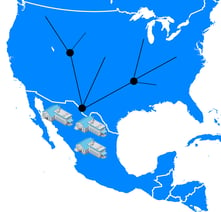
Ford recently made headlines when it announced that it would be moving its small car production from Michigan to Mexico. And, while the outsourcing of manufacturing from the U.S. is nothing new, there is another movement afoot that is reshaping the North American supply chain.
Nearshoring (outsourcing of business processes to a nearby country) to Mexico has been on the rise for several years and shows no signs of slowing down.
(Two-way trade between the U.S. and Mexico totaled $531 billion according to the U.S. Trade Representative in 2015. Imports, which accounted for $295 billion, has increased by an astonishing 73% since 2005.)
The manufacturing operations that are nearshoring to Mexico, however, are not necessarily coming exclusively from the United States. In fact, a large portion of this movement is actually coming from overseas countries, such as China, that have been utilized by U.S. companies for manufacturing in recent decades as a result of their lower production costs.
Now, many U.S. industries, such as the automotive sector, are moving their operations south of the border as well.
Why are these industries nearshoring their operations? Some reasons include:
- competitive labor costs
- closer proximity to U.S. plants
- shorter lead times
- more dependable supply chain infrastructure
As more businesses in the U.S. see portions of their supply chain nearshoring to Mexico, it's important to evaluate the risks and develop rock-solid strategies for moving freight across the border.
Challenges of Shipping Cross-Border Cargo By Rail
Potentially the biggest challenge for cross-border shipping is the inundation of cargo volume that is hitting the rail on northbound freight trains from Mexico to the U.S. Freight trains around the border already move fairly slow as they pass through densely populated areas. Together with the strong demand for rail capacity, shippers are facing a frequent delays.
During peak production times, the tightened rail capacity often forces manufacturers to slow down output or seek alternative transit solutions, including truckload and even ocean and air services.
For that reason, shippers need to monitor cross-border capacity very closely. If you ship primarily by rail, work closely with your service providers to quickly secure back-up transit options when capacity is crunched or rail congestion is high.
Working with a transportation provider that offers multimodal options can help simplify your options when preparing for capacity issues.
TAKE ADVANTAGE OF BORDER DISTRIBUTION FACILITIES
 If you're moving goods northbound from a manufacturing plant in Mexico, utilizing a cross-border facility for transloading and distribution can help you save money and time.
If you're moving goods northbound from a manufacturing plant in Mexico, utilizing a cross-border facility for transloading and distribution can help you save money and time.
Facilities near border hubs, such as Laredo, El Paso, Del Rio and Harlingen, make it easier to move goods between carriers on both sides of the border. Border facilities can also be used to deconsolidate imported freight for LTL distribution throughout the United States, which is particularly helpful if your freight is heading to different destinations.
When choosing a border facility, look for facilities that are close to the international bridge to reduce cross-border transit times. Plus, ensure that the facilities have adequate security for round-the-clock monitoring of your freight.
Don't Let Customs Become A Roadblock
If you've ever seen photos of the lengthly lines of trucks at border crossings, you can imagine that the customs clearance process can be a real headache. Fortunately, Mexico and U.S. customs agencies are seeking ways to work together to simplify the process.
One pilot program has reduced the inspection process from several hours to a mere 25 minutes!Still, it's pertinent to have all of your cross-border customs documentation in order. The smallest infraction on paperwork can result in potential delays.
Always work with a trusted customs broker. They will become your best friend when it comes to moving your freight across the border. If you don't already have a customs broker, ask your cross-border carrier or service provider for referrals. Some carriers actually have in-house customs brokers that can help streamline the entire process.
Seek Strategies To Simplify And Streamline Your Cross-Border Supply Chain
The nearshoring of manufacturing to Mexico is forcing many logistics and business managers to rethink their supply chains. Opportunities and risks are abundant, and navigating your way through them will require careful research and planning.
Ask yourself:
- What services does my supply chain need from origin to destination?
- What is the biggest challenge to my cross-border supply chain?
- What are the pros and cons of each transportation mode that I'm currently using out of Mexico? (Rail, Road, Air, Ocean)
And more importantly:
- Can I reduce the amount of hands touching my freight by utilizing fewer service providers or perhaps even one?
By limiting the amount of points on your supply chain, you can minimize the potential for losses, damage and delays. Some handoffs will be necessary, such as transloading between Mexican and U.S. carriers or between container and trailer.
Nonetheless, a leaner strategy will give you more control and flexibility when you need it. Likewise, the more you can simplify your supply chain by working with reliable transportation service providers; the more you can spend focusing on growing your business.
If you would like to learn how Averitt can help you ship cross-border with ease and comfort, check out this short video!







